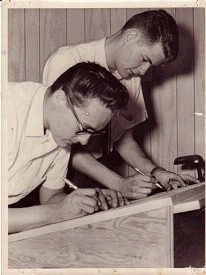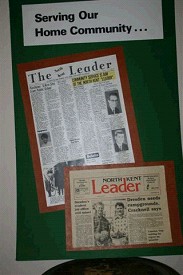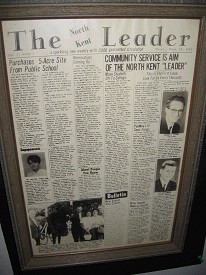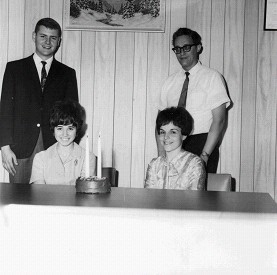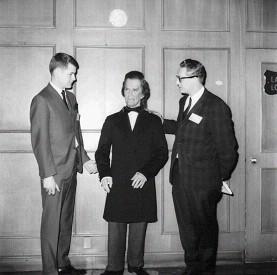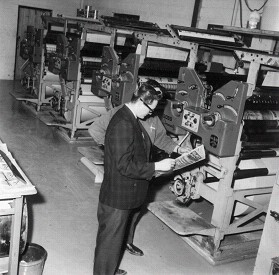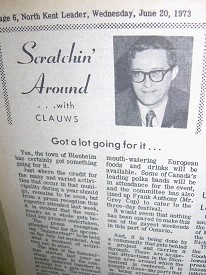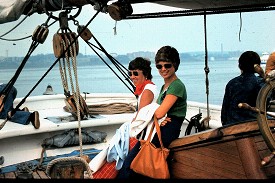Presenting the 1965 to 1988 Story of Leader Publications Limited under the ownership of partners Clauws and Misselbrook
Follow The Leader
From the founding year in 1965 to the sale of the company in 1988.
This segement presents the years 1965 to 1969:
EDITORS NOTE
Now available on line a series of pages and photos that will attempt to tell the Leader Story from its humble beginning in 1965 to 1988 the year Leader Publications Limited was sold to a Sudbury publisher.
We hope you will enjoy our efforts, as the story unfolds on these pages and future chapters.
Leader Story writer and researcher Gord Clauws :
Leader Story researcher and photo editor Ted Misselbrook:
Presenting Chapter One: The Leader Story 1965-1969
Clauws and Misselbrook Partnered The Creation of Leader Publications
HISTORY OF LEADER PUBLICATIONS
When one attempts to put into writing the history of Leader Publications Limited, roadblocks seem to appear out of
nowhere.
Where does one start?
Just how much information should be included?
Are you sure all the facts are factual or has memory managed to allow some important aspects to drift away?
Well, one could probably procrastinate forever, but I guess the place to start is with concept.
That started back in early 1965. Gord Clauws was working at the Dresden News at that time and Ted Misselbrook, co-founder of The Leader was selling advertising for the Chatham Daily News.
For many months, some of the merchants in the town of Dresden had expressed an opinion to Clauws that something should be done to enliven the local weekly. There were no editorials or very few and many events that were occurring in the community were being ignored. Clauws who was the main writer at The News, at that time, had very little control over what was appearing in the newspaper since the owner at that time, Charlie Ross, did not want to hire more people, nor did he really seem concerned over the public's perception of the newspaper. He was making a comfortable living and that seemed to be all that mattered to the Ross family.
A couple of those merchants who were instrumental in spuring Clauws' interest in starting a competing newspaper were Mel McKaig of McKaig Furniture and Appliances and Al Dolson, the manager/owner of Dolson's Foodmaster.
After contemplating just what would be involved in setting up a competing newspaper, Clauws sought out Ted Misselbrook to see if he was indeed interested in such an endeavour.
When the idea of a newspaper came to the forefront in the mind of Clauws, he knew that he had to have someone who could sell advertising, the heart and sole of a successful newspaper. The first person to come to mind was friend Ted Misselbrook, who three years earlier had worked at the Dresden News as well. Ted was a natural when it came to selling advertising and after lengthy discussion, the decision was cast...they would start a new newspaper in the Town of Dresden.
While Misselbrook wasn't long making up his mind to join Clauws in this new publishing venture, he did have a few concerns about the timing. Misselbrook had married in June of 1965 to Patricia Stinson, and the two had moved to Chatham and had rented an apartment home on Lacroix St. Pat had also secured a full time job at the Bank of Montreal. The young couple, (Ted was 20 and Pat 18 years of age) had also signed a bank note and bought a new 1965 Chevy Biscayne. As well the management of the Chatham News had raised his pay to a whopping $85.00 a week, with a promise of more to come in three months time, along with a transfer to another city, and a increased pay package within a year's time. The General Manager of the day, Jack Bowers, also told Misselbrook that he was likely to become the youngest advertising manager to date in the Thompson Newspaper chain.
It seemed like a lot to give up! Pat and Ted spent a few days talking over the situation. They decided that if Ted didn't accept the opportunity to partner up with Clauws and try on newspaper ownership, it would be something he would regret for the rest of his life. That was the perfect decision, notes Misselbrook. "Gord and I would go on to have a great career, a fantastic partnership, and wonderful friendship, who could ask for more".
One of the most enlightening facts of setting up a newspaper at that time was that "offset printing" was just coming into its own and meant that the putting together of a newspaper was much simpler than using the old method of "hot type".
These advances in printing technology meant that little more than a couple of typewriters, "strip-printer", scissors and knives and a central area web press was all that was needed to get into the business. Clauws was already into the photography business to some degree and had a "home based darkroom". Many nights of discussions were staged between the two young men as they made plans for establishing of the newspaper. No one seems to know for sure today how the name "North Kent Leader" came about, but it was the name chosen and from a very small, humble beginning, a business endeavour was started and would continue for nearly a quarter of a century before the two entrepreneurs would sell and retire from the newspaper business.
Some very simple facts can be recalled about those early days. The company simply would not have been had it not been for a small group of Dresdenites who provided the support and encouragement needed to pull the loose ends into a workable package.
The late Lloyd Wismer, then manager of the local Toronto-Dominion Bank, provided the asked for $2500., to be used as a portion of the initial investment for the proposed venture. The loan, which was unsecured, was the thurst needed to make things happen for 23 year old Gordon Clauws and 20-year-old Ted Misselbrook . At that time, as stated, Clauws was editor of The Dresden News and Misselbrook an advertising sales representative at the Chatham Daily News.
Besides the $2,500 "seed money" that Wismer arranged for the twosome, additional funds were obtained through a finance company and some private money from Clauws' mother. "I think we had about $4,000 in total" said one of the partners.
The decision to locate on the main street in the downtown area was made simply because a store front was available. The 700 square foot building was owned by the family of the late Leta McDuffie who had operated a successful grocery store from that location for many years.
Many other aspects of setting up the newspaper were also needed, and it must be pointed out here that all the prep work had to be done "undercover" since both Clauws and Misselbrook were holding down regular jobs. Both had married within the year prior to publishing the first edition on September 15th, 1965, so both felt a dire necessity to make a success of the endeavour.
Don Spearman pounded-out the weekly editorials!
Equipment was another of the very important aspects needed to get the first edition ready for printing and here contacts that Clauws had with major newspaper suppliers came in handy. One of those supplier was Canadian Fine Color in London, Ontario. The two entrepreneurs journeyed to London to meet with officials of that firm and again it seemed a streak of luck was working for the two as an agreement was reached that a "strip-printer" would be supplied, as well as photographic paper, chemicals and a host of other needed supplies. No promissory note, no cash up front...only a promise that we would make the necessary payments as required.
By the late summer of 1965 things were starting to come together. There was, however one other very important aspect of the initial planning that came to be.
Both Misselbrook and Clauws knew Don Spearman, owner of Observer Press, a commercial printing operation in Dresden. Spearman was more or less Clauws' mentor in the early days at the Dresden News. Spearman had been editor, among other duties, at The Dresden News for several years, and in early 1960 decided to leave that operation as well and strike out on his own. He chose the village of Hensall in Huron County to start his newspaper. He continued there for about three years before selling the newspaper rights to a neighbouring newspaper and moving his commercial printing operation to Dresden.
Spearman was an excellent writer and wanted to see the two young men succeed. He offered to write the editorials for the first edition and that turned into a near full-time job as he toiled weekly pounding out editorials that were as local as city hall and as timely as the dateline on the newspaper. Clauws and Misselbrook today, both reflect that had it not been for his willingness to work horrendous hours with no pay, the company may very well have perished early.
Clauws, who was a bit handy with a hammer and saw, spent many night-time hours building wooden tables on which "light tables" were set to assist the paste-up activities for each page of the newspaper. Misselbrook kept busy with his evening hours by preparing "spec-layouts" and advertising promotions, so that he would be ready to sell for the first edition of the North Kent Leader.
By early September of 1965 everything seemed in order and both Clauws and Misselbrook gave notice to their respective employers that they were leaving those companies.
Clauws recalls telling his employer, Charlie Ross, that he had other plans for his life, but Ross, who apparently kept his ear to the ground, had already heard the rumours that a second newspaper was being contemplated for the town of Dresden, and confronted him. " I told the truth and said that that was indeed the plan," Clauws reminisces, " I told Ross that I had lived on promises of being able to buy into the Dresden News for too many years." In any event, the die had been cast and the two entrepreneurs were off to start their new adventure.
The first edition of the North Kent Leader was published on September 16th, 1965 with a circulation of 3000 copies.
Clauws and Misselbrook presented the first edition of the North Kent Leader on September 16th, 1965:
After the first week of preparing for the initial edition, it was discovered that an additional employee would be required to assist in typing the news stories, waiting on customers etc. And, hence, the first employee of the North Kent Leader was Doris Stevens (who a couple of years later married Dresdenite Gary Ross) and who still resides in the town of Dresden.
Prior to the printing of the first edition, and after the equipment had been installed that Canadian Fine Color supplied, an actual "printing press" was required. With the advent of offset printing, a Western Canada firm had set up an offset printing plant in London, Ontario and agreement reached that they would provide the necessary printing requirements. The firm was known as Webco Publications, and was owned by Bowes Publications from Alberta. It is a bit ironic that Bowes Publishers would have a very close connection to the town of Dresden. Some ten years prior to the establishing of The Leader, the three Bowes brothers, Jim, Howard (Howie) and Bill, who hailed from London, had operated the Dresden Times, a weekly newspaper in opposition to The Dresden News. The brothers decided in 1955 that more opportunities were available in the province of Alberta and they pulled up stakes and moved to that province to purchase a weekly newspaper in Fairview, Alberta. From that humble beginning, Bowes Publishers developed into a major publishing firm that dominated much of small-town Alberta before they ventured back to Ontario. Another connection that the Bowes family had with Dresden was that one of the brothers Howie Bowes, married a Dresden girl, Marilyn Quick, daughter of prominent insurance agent Orvil Quick. A lasting friendship developed between the Bowes families and the Clauws and Misselbrooks that endured until retirement years.
The premier edition was a "work of art" as far as the two owners were concerned, and there seemed to be similar opinions circulating throughout the community. " I recall many people sticking their heads in the door of our Main Street office to simply say "what a great job we were doing and to keep it up" Misselbrook recalls.
The initial North Kent Leader reached its budgeted revenue made up from a list of business advertisers that secured the financial success of the first edition.
For that reason alone, the partners shall always think fondly of businesses which supported them in the first edition of the North Kent Leader. They are Rich-Hill's Men and Boy's Wear, Observer Press, Dolson's Red and White Foodmaster, Robinson-Thomson Lumber Co., Lambton-Kent Grain, Murphy's Farm Equipment, Pegg Valu-House, Byron McKim and Son Ltd, Weese Footwear, Duff Florist, St. Clair Grain and Feeds, Dresden Farm Equipment, McKaig Furniture, Duff Motor Sales, Simpson's Food Market, The Aiken Company and Geo. K. Coyle Clothing.
The only advertisers in the first edition that remain active businesses today (2009) include Clark's Fuel and supply, Dresden Hardware, McBrayne Feed and Supply and of course the Leader.
The headlines of the day in the premier edition were also very interesting for the citizens of Dresden. The brand-spanking new Post Office on Main Street was holding an open house that week and the announcement by the Lambton-Kent District High School that a new "Composite" school would be constructed in north Dresden on the site of the old Dresden Public Continuation School.
THE MOVE TO PAID CIRUCLATION
With the first edition of September 15th, 1965 the decision was made by the two partners to blanket the entire town and surrounding area so that every household received the new community newspaper. It was a good plan. The paper was well received and the decision was soon made to attempt to turn the distribution system into a paid format.
Enter the picture....Jack Thomson. Thomson was a natural salesman and had moved to Dreden a year before the birth of The Leader. Actually Thomson had been the number three man in the chain of command for Beaver Lumber Company. Jack often told the story that prompted his move to Dresden. "I looked around one day and saw that there were no 'old Beavers' in the organization," he would lament, "and I knew it was time for a change." That change came in the way of Uncle Tom's Cabin, at that time, a relatively unknown tourist attraction . Thomson whirl-winded into Dresden and brought major changes to the local attraction. He soon found, however, that additional funding was required and he took on the job as "subscription salesperson" for The Leader. Thomson came on board November 18, 1965.
As was said, Thomson was a natural salesperson and soon brought in hundreds of first-time subscribers. The circulation list grew and both Thomson and The Leader benefited greatly. The company got extra funds into the coffers and at the same time was able to inform advertisers that the newspaper was indeed well read and received with the proof being in the paid-circulation list.
While Thomson was the first subscription sales person for the Leader, he was not the last. After a few years Thomson's interest changed and he left his sales job at Leader. To take over that position was Lorne Broad of Tupperville. Broad was a quiet individual and while not pocessing the same salesmanship as Thomson continued to fulfill that job until his untimely death a little over a year after joining the firm. Broad died in August 1970.
Taking the reins of the subscription list following Broad was probably one of the best known characters to ever sell subscriptions in Canada, Alex (Red) Blackburn. Blackburn had retired as clerk of Camden Township about the same time as the death of Broad and approached the two partners of The Leader about the sales job.
He did a bang-up job for many years before he retired as well.
But, back to the time-frame in the devlopment of what would eventually become Leader Publications Limited.
MORE NEW EQUIPMENT
In 1966 the partners saw a need for another piece of equipment that was vital to the production operations of the newspaper and one that could save the company much money over a period of years. The equipment was a graphic arts camera, a huge instrument that could photograph two pages of the tabloid-sized Leader at one time, and thereby saving many dollars that were being spent with the London printing firm to complete the same process. The purchase of the graphic arts camera was made with Bill Sears, son of the founder of a Toronto-based printing supply company, Sears Printing of Canada.
Again, an agreement was reached between the two partners and Sears to provide the equipment with little down payment and a handshake on the promise to pay the balance. Although this time, neither Clauws nor Misselbrook can recall the exact price of that piece of equipment, the sum that dances in their minds was around the $3,000 mark...a princely sum of money in the eyes of the two partners. It was ironic, again, that Bill Sears, son of the company president that sold us the equipment would become great friends of Misselbrook and Clauws, and that friendship endured until the early 1980's when the Sears company went out of business.
Bob Brooks of Sears Printing Supplies of Canada is shown in this 1966 photo along with North Kent Leader partner Ted Misselbrook. Brooks had just installed the Leader's new graphic arts camera, and was busy showing Misselbrook the skills needed to run the camera.
1966 was an important year in the growth of The North Kent Leader!
THE SECOND YEAR
Nineteen sixty-six (1966) was also another important year in the history of The Leader, although the event that occurred had no direct bearing on the company.
Pat Misselbrook, wife of Ted and Marilyn Clauws, wife of Gord, would start employment at the two banks in Dresden on exactly the same day. Marilyn was hired by the Toronto-Dominion Bank with manager Lloyd Wismer in charge; and Pat was hired by the Canadian Imperial Bank of Commerce with Walter Hornell as manager.
It was somewhat of a joke around Dresden at that time that the two founders of The Leader "covered all the bases by having one wife in each of the banks."
THE SUPER SALESMAN
By 1967 the work load had increased in the production department, pimarily because of the increased advertising that partner Misselbrook was responsible for bringing in the front door. Clauws recalls conversations with businesspeople who often related that old adage about Misselbrook, "he could sell ice cubes to Eskimos".
And that probably wasn't too far from the truth. But , even Misselbrook, will agree one one aspect of his selling abilities: The Thomson Newspaper organization had one of the best and most brilliant sales training programs in the industry. Misselbrook, of course, was a graduate of that course, having worked at the Chatham DailyNews for three years before helping establish The Leader. One aspect of that training program was the use of "spec ads". As soon as one week's edition was completed, Misselbrook would spend countless hours drafting "spec ads" for the many merchants in and around Dresden. Those spec ads were never of a small size, but the content provided by Misselbrook left the merchants and business people simply wanting to buy the "spec ad". On rare occasion, the merchant would suggest that perhaps a little smaller ad would provide the same results, but again Misselbrook's persuasive sales abilities would come forefront and the "spec ad" would usually require only minor changes before heading to the composition department. Misselbrook would also introduce to weekly newspaper publishing a platform of "special editions and advertising features." Special editions published would run the gauntlet from Brides and Farm Editions to Fire Safety Week, Shop at Home and everything in between. Area merchants took to the concept in a big way and supported the efforts of The Leader by rewarding it with even larger chunks of their advertising dollars.
THE GROWING PAINS CONTINUED
As stated, things got a little busier by 1967 and the need for an additonal employee became evident. Enter the picture, the Leader's second employee...Peggy Conrad. Peggy was an eastern Canada native (from Nova Scotia) and she and her husband had landed in Dresden because of a job offer by Canadian Canners to her husband Eric. The couple stayed in Dresden for a couple of years, during which Peggy became an invaluable employee, before they headed back to their native province.
After Peggy Conrad left, another local girl was brought onto the scene, Joyce Martin, wife of Donald Martin, a farmer in Camden Township, joined The Leader about in 1969. Joyce's stay with The Leader, however, was relatively short as she became burdened with the dreaded disease cancer. Joyce worked for the Leader about one year and actually worked almost up to the time of her death. Joyce had given birth to her only daughter just weeks before her death at an age of slightly over 25 in 1970.
SAD MEMORIES OF DEDICATED EMPLOYEES
Joyce's death was the first of four employees who would die while in the employ of The Leader and subsequently Leader Publications Limited. The others were subscription sales person Lorne Broad; reporter Brian Park; and pressroom foreman Mac Johnson. Each were valued employees and their untimely deaths were different in each case. Lorne Broad died at the dinner table of a massive heart attack after selling subscriptions for less than two years. Brian Parks' death was the most devastating. Brian was a reporter for the Voice of the Essex Farmer, one of several farm oriented publications that would come onto the Leader scene. During the spring of 1979 while travelling enroute to an assignment in Leamington, Brian's company car skidded on the slippery highway and he was severely injured, including a ruptured spleen. After months in the hospital in his hometown Sarnia, he recovered and returned to work. His work session in the late summer of 1979 was cut short as while driving in a rainstorm to Chatham on Highway 40, north of the city, he was hit headon by a oncoming car which was passing traffic at the time. His untimely death left many saddened fellow workers, but his memory was not to be forgotten. The Leader established a trophy for the most improved player in one of the minor hockey teams in Dresden. That trophy was awarded annually for many years and perhaps still is. Brian was in his mid-20's when he died.
The last employee to die while in the company employ was Mac Johnson. Mac came to The Leader when the web press operation was purchased from The Petrolia Topic in the early 1980's. Mac was the head pressman and foreman for The Leader at its new press building at the time. A rather rugged individual, with an addiction, but one that many press operators of that time seem to possess, Mac was a heavy drinker, but a good worker. He was seldom late for work and would stay until the job was done, even if it meant the wee hours of the morning after a 20 hour stint.
Mac fell victim to cancer in the mid 1980's and soon succumbed to the deadly disease. He was in his early 40's when he died.
WE BEAT THE TAX DEPARTMENT
The year 1967 was indeed a significant period for The Leader, which by this time was an established entity in the town of Dresden. Since its inception The North Kent Leader had used typewriters to produce the news columns of the weekly endeavour. While doing the job, it was decided by the partners that a more appealing and professional look could be had by having both sides of the column "justified". Hence the decision was made and "Justowriters" were ordered. These machines were ordered through an Ontario firm but were manufactured in California. Three units were ordered...two input units which resembled glorified typewriters but which actually punched codes into tape approximately one-inch in width. The punched tape was then inserted into an output unit which produced the finished typed column which were "justified" on both sides.
The North Kent Leader had indeed stepped into the big leagues. The Leader would now have the look and feel of a more contemporary and traditional newspaper.
But, there was one problem that arose. The machines were ordered in November with a delivery date promised by year-end. That did not happen, however, and the machines did not arrive until sometime in February. While it was only a temporary delay, there were other problems that would arise.
Our accountant, who came on board following the establishing of the business in 1965, John Laken of Richardson and Laken Accountants in Chatham, decided when producing the 1967 tax returns that the newly ordered machines should be depreciated, even though they were not yet on the premises.
Being somewhat naive about filing business income taxes, the partners saw nothing wrong with the decision since the machines had been on order since November 1967.
Enter the Tax Department. Apparently our next door St. George Street neighbour at the time, Art's Flowers (owned by Art Wachsmuth) had approached the tax department with the suggestion that he be allowed to destroy past year's records, simply because he was running out of storage room. The Tax Department obliged and sent out auditors to complete an audit before allowing the records to be destroyed. The Department, in its apparent wisdom decided that since they had to go to Dresden they might just as well do a couple of other audits. And sure enough, The North Kent Leader's name was randomly drawn and the firm was in for its first official tax audit.
While we were relataively sure that everything was in order, there was concern on the part of the partners. And, sure enough, after three days of poring over the past two year's tax returns, the auditors questioned why we would depreciate equipment that had not yet been received. That was simply not in the tax books as an allowance and the auditors told accountant Laken that the tax returns for 1967 would have to be redone taking out the depreciation factor for the machines. Realizing that the machines were well over the $5000. mark, it would make a sizeable change to the meagre tax returns that the firm was filing at the time.
John Laken, however, didn't agree with the Tax Department and travelled to London to appeal the auditor's decision. He maintained in his argument that the Justowriter machines were built to the specifications of The Leader (which they were) and that as such the machine didn't actually have to have been received to be allowable for depreciation. We thought it was a "stretch" but Laken persisted and sure enough, the Tax Department finally agreed and we were off the hook to reproduce the previous year tax returns.
It's interesting to note that Laken continued as the firm's acountant until the partners sold in 1988, and to this day, he is still the personal accountant for the two founders.
Celebrating the second year of the North Kent Leader, with a simple birthday cake and two candles are partners Ted Misselbrook and Gord Clauws with staff Doris (Stevens) Ross and Peggy Conrad.
A birthday celebration of sorts, was held at the downtown office with cake and coffee to commemorate the 2nd full year of newspaper publishing.
THE WIVES WERE INVOLVED AS WELL
The year 1967 also brought continued growth to The North Kent Leader and one of the founding partner's wives fondly recalls one episode that involved both wives. Marilyn Clauws was pregnant for their first child due in November 1967. She was on maternity leave and Pat Misselbrook apparently had the day off when they were both pressed into service to "insert" sections of the newspaper. They accompanied the two partners to the London printing firm where that particular week's edition was in two sections. Marilyn recalls it was about a week before son Shawn was born and she was perched on a stool attempting to reach two piles of newspapers to be inserted. It was an amusing site and one that was not soon forgotten.
FIRST CONVENTION
The year 1968 continued to be a "growing" period for the firm and two significant events were recorded.
The first was in the spring of that year. The Leader had been persuaded to join the then Ontario Weekly Newspaper Association the previous year and the two partners decided that it would be a good idea to "spread their wings a bit" by attending the annual spring convention of that organization. It was being held in Niagara Falls and the two partners drove to the convention on the opening day....a Thursday. Since conventions were always billed as "family affairs" it was decided that the wives should join in the activities. Since both were still working full time at their respective banks, the two could not get away until the Friday of that week. The two drove to Chatham and got a bus that would bring them to The Falls later that evening. That was the first convention that the partners attended and would become an annual event for the two, along with their wives and children, right up to the time they sold the company in 1988.
THE BOLDEST MOVE YET
One of the biggest undertakings that the partners were involved in during the formative years of the company was the purchase of the Dresden News.
The News had been in the Ross family since its inception in 1938 and the son of founder Art Ross was activily involved in running the business during the 1960's. Charlie Ross was somewhat of a formidable competitor in the newspaper business and he didn't take it well that the new kids on the block where taking over the newspaper market in the Town of Dresden. Charlie's health was not the best and while fighting cancer he apparently decided to "throw in the towel" and exited by his own hand. That was in late 1967. His daughter, Karen, attempted to keep the newspaper running, but it was a frugal effort and the paper was sold to a Toronto entrepreneur by the name of Ton Denning.
Denning was of Dutch descent and was the publisher of the Holland News a weekly newspaper that was printed in the Flemish language. He made the move to Dresden with great fanfare and one amusing aspect is often recalled when the two founding partners reminisce about those days.
Misselbrook recalls that the first day Denning hit town he issued him an invitation to drop in to our office as an opportunity to meet his opposition. Denning took the pair up on the invitation and during the short visitation, Misselbrook told Denning outright "If you decide you don't want to stay in Dresden, for whatever reason, give us a call, we might be interested in buying the Dresden News."
The two newspapers continued to battle head-to-head, but it was clearly evident that The Leader was slowly pulling out front. Within a year, Denning accepted the invitation for discussions and the publishing rights to The Dresden News were acquired by The North Kent Leader. The purchase price was established at $6,000.
After making the offer, the partners were perplexed. Where were they going to get the $6,000. to pay Denning off? Enter the picture...Ernie Wilmott of Wilmott Motors, the Chevrolet/Oldsmobile dealer in Dresden. Wilmott volunteered to secure the necessary loan if they were unable to raise the funds on their own. The Leader was doing business with the Toronto-Dominion Bank at the time and manager Cliff Cox was adamant that he would not supply the necessary funding without a co-signer. Wilmott, however, banked at the Bank of Commerce and once it was revealed that we had a backer, albeit one from another bank, Cox became concerned that we just might change banks. "We might even had offered a slight hint that that could happen," Misselbrook recalls.
In any event, Cox finally gave in and provided the necessary funding without a co-signer.
The two partners have often marvelled at the faith Wilmott had in making such an offer to two young and relatively inexperienced businessmen.
The deal was completed in November of 1968 and besides the publishing rights to The Dresden News, another publication The Kent Farmer, arrived on their doorstep. At the time however, the pair had enough challenges on their plate with the building of their own newspaper. So, the county-wide farm publication that owed its beginnings in 1966 to Charlie Ross, was packed away on a shelf.
With the acquistion of The Dresden News and the amalgamting of the two subscription lists, the two partners were "off and running" with renewed enthusiasim that would carry them into the next decade of the '70's.
A SPARKLING NEW WEEKLY WITH
3000 GUARANTEED CIRCULATION
That was the motto that the founders promoted throughtout the early years of The Leader.
As in the case with the vast majority of newspapers, it is the advertising columns that "pays the bills" and the news columns that bring in the readers.
Such was the case with The Leader. The advertising columns being generated week after week through the salesmanship of Misselbrook were indeed "paying the bills" and the news columns, under the direction of Clauws, tempted the readers to continue to support the newspaper through continued growth of the subscription list.
The paper prided itself in the content being produced through local news stories, features and crisp clean photography that the offset printing process allowed. The editorials, being prepared each week, for the most part, by Don Spearman, were local and forceful. "I don't recall backing down from any controversial subjects during those early years " opined Clauws. "We became respected for the stand we often took, even if it was not always in the favour of local politicians or business people."
Another feature that "caught on" with the readers was a column started by Clauws not long after the paper premiered. That column "Scratchin' Around With Clauws" would run the gauntlet from events at local council to personal episodes of the Clauws family, and almost everything else in between. It is interesting to note that Clauws continued to write that column for 19 of the 23 years that the partners owned the company...over 900 weekly presentations.
While there were many news stories of note that The Leader covered during the early years, there is one event that stands out a bit more than the others.
That was the flood of February, 1968. It was a most devastating occurrence for the town of Dresden as the Sydenham River swelled beyond its banks and inundated a large portion of residential properties and businesses lying between Queen St north to the bridge spanning the river. Many homes in the area had two to three feet of water and in some cases more on their ground floors. Businesses, including Wilmott Motors near the bridge had over five feet of water in its service bays.
The Leader team, comprising Clauws and Misselbrook, took to the new streets of water in a boat to caputre the devastating damage on film. It was disappointing that the flood would occur two days after the regular weekly publishing day.
After viewing the damage and the heartbreak that many residents were undergoing, the decision was made within hours that a "special edition" was in order. The partners, who had moored their borrowed boat to a tree in the front yard of the Anglican Church at the corner of Queen and St. George Streets, returned to their office and started the endeavour. It was decided that advertising could not be sold in time to help defray the pending publishing costs of a special edition, and hence an eight-page tabloid paper was produced within 24 hours of the time that the first pictures were taken.
The paper was a "masterpiece" in the minds of the two partners, and it was well received by the subscribers and new readers. Favourable comments over the efforts put forth in getting the special edition on the streets within the time limits noted were numerous. "I think we even scalped most of the dailies on that story, " Clauws recalls, "the night of no sleep for the two of us certainly paid big benefits".
LIFE IN THE '60'S
As the partners recall today, living back in 1965 was much different than it is today. Times were more relaxed, prices were lower, but then again, so were the wages.
Misselbrook recalls those early editions of 1965 when a 2 column x 5-inch advertisement for McFadden Grocery Store was billed at $5.60. "It seems to me we needed to sell 600 inches of advertising weekly back then to pay the bills," the astute now retired advertising salesman opines, "600 times 70 cents per column inch grossed us about $420.00 a week." Considering that the two partners paid themselves $70.00 a week (before deductions), it didn't leave much for the other expenditures, including the wages for a secretary/typist and rent on the building.
But to offset those meagre wages of the day were the great prices that prevailed for most staples of life.
In the premier edition of The North Kent Leader it was advertised that you could buy six 10 ounce cans of tomato soup at Simpson's Food Market for 69 cents....one tin of soup in 2009 is about the same price. You could buy two loaves of bread for 39 cents, the price today at Foodland is $1.79 for one loaf. And, a 10 pound bag of onions at Dolson's Foodmaster cost 49 cents....the price today $1.49.
Clauws recalls the year before they started the business. He purchased a new 1964 Chevrolet Super Sport Chevelle for a little under $3500.
A VERY SIGNIFICANT AND WELCOME LETTER
Almost three and half years ( it was exactly three years and 161 days) after the initial edition of the North Kent Leader hit the street, a most welcome letter was received by the two partners.
From Canada Post came the announcement that The North Kent Leader had qualified for second class mailing privileges, having met all the necessary requirements. The February 24, 1969 letter stated that henceforth The Leader could carry in its masthead the following: "Authorized as Second Class Mail by Canada Post".
The main criteria for qualification for second class mailing privileges was the fact that the copies had to be "paid in nature". The drive to establish a paid circulation base had paid off.
To the layman that probably didn't mean much but to the two partners it was the most welcome news of the year.
What it did was allow us to mail "Free of Charge" up to 2500 copies addressed for delivery to places not having letter carrier delivery services but within a 40 mile radius of the place of mailing.
This was indeed a significant time since it meant a substantial savings in postal costs each week. "it probably only meant between $60 and $90. a week in savings, but at that time in history, it was a substantial amount," commented Clauws.
Ted Misselbrook and Gord Clauws are shown with Sir John A. MacDonald at the world famous Louis Tussaud's wax museum in Niagara Falls. Clauws and Misselbrook attending their 1st Ontario Newspaper Convention in 1968, and would continue the tradition over the next 20 years.
Printing of The Leader would shift from London to Tilbury in 1969
A FINAL CHANGE BEFORE THE NEW
DECADE
One of final changes that was made to the operations before the end of the 60's was a change in printers. Since its inception The North Kent Leader had been printed in London by Webco Publications.
It was always an hours drive to get to the London location and at times, especially when the area was snowbound in the winter months it became a rather treacherous adventure.
Hence in 1969 the decision was made to change printers, moving to Community Web Printers on the outskirts of Tilbury. That firm was owned by Jerry Houle who had opened the printing plant a year or two earlier. The move made it much easier since the drive was only about 35 minutes on a clear day.
The Leader would continue to be printed by the Houle firm until 1976 when another move was made...this time to Petrolia.
"Scratchin' Around with Clauws" appeared more than 900 times in The North Kent Leader!
"Scratchin' Around With Clauws" had over 900 weekly presentations and was published 19 of the 23 years that Clauws and Misselbrook owned Leader Publications.
A COUPLE OF NOTEWORTHY EVENTS OF THE 60's
On a very personal note, two events were noted in the lives of the partners. Gord and Marilyn Clauws, announced the birth of a son, Shawn Gordon, on November 3, 1967 and Ted and Pat Misselbrook were looking forward to the arrival of their first born. She would enter the world as Jill Lynn Misselbrook on Feb. 6, 1970.
THE END OF AN EXCITING DECADE
As the sun set on the 60's, it will be recalled as a decade of excitement throughout the world that included the assassination of a U.S. President and the now famed words of Newscaster Walter Conkrite "The Eagle Has Landed" in the summer of 1969 as Astronaut Neil Armstrong stepped down on the surface of the moon announcing, "One small step for man...one giant leap for mankind".
As kids throughout Canada and the United States were glued to their black and white television sets to see the debut of a new children's program "Sesame Street" and teens were dancing to the music of Neil Diamond's "Sweet Caroline" and "These Eyes" by the Guess Who or "Aquarius" by the Fifth Dimension, the two partners were looking forward to a new era with enthusiasm and ebullience.
Pictured are Marilyn Clauws and Pat Misselbrook from a photo taken in the mid to late 60's at a annual newspaper convention.
